Archives
- By thread 5344
-
By date
- June 2021 10
- July 2021 6
- August 2021 20
- September 2021 21
- October 2021 48
- November 2021 40
- December 2021 23
- January 2022 46
- February 2022 80
- March 2022 109
- April 2022 100
- May 2022 97
- June 2022 105
- July 2022 82
- August 2022 95
- September 2022 103
- October 2022 117
- November 2022 115
- December 2022 102
- January 2023 88
- February 2023 90
- March 2023 116
- April 2023 97
- May 2023 159
- June 2023 145
- July 2023 120
- August 2023 90
- September 2023 102
- October 2023 106
- November 2023 100
- December 2023 74
- January 2024 75
- February 2024 75
- March 2024 78
- April 2024 74
- May 2024 108
- June 2024 98
- July 2024 116
- August 2024 134
- September 2024 130
- October 2024 141
- November 2024 171
- December 2024 115
- January 2025 216
- February 2025 140
- March 2025 220
- April 2025 233
- May 2025 239
- June 2025 303
- July 2025 157
-
Do you know your work persona? Why that should matter more than ever to employers
McKinsey&Company
Attract five types of workers .

Talent search In the news • Second thoughts. In the US, roughly 20 million workers quit their jobs sometime between January and May 2022. Now, some of them are having second thoughts. About one in four workers are questioning their decision to quit, according to a survey of more than 15,000 people. Of those who started a new job after leaving their old one, 42% report that the new position isn’t what they were expecting. However, workers in some fields (such as healthcare) expressed much less regret. [Bloomberg] • Counteroffer with caution. To keep star employees from leaving, it’s tempting for employers to dangle the prospect of better pay and promotions. Offering a generous raise makes sense when considering how much it costs to replace workers. But unless properly handled, making a counteroffer could backfire. A big pay bump might leave workers fuming about having been previously taken for granted. It may also make other workers think that they’ve paid a “loyalty tax” for being committed to the company. [FT] 

On McKinsey.com • New trends. Competition for talent is still fierce. But new trends are making it even harder to woo workers, find McKinsey senior partners Aaron De Smet, Bill Schaninger, and colleagues. Many workers are not just leaving their old jobs behind; they’re also leaving their industries. Of the employees who quit in the past two years, just 35% took a job in the same field, while 65% either found a new line of work or left the workforce, reveals a new McKinsey survey. Employers are competing within their industry and across industries, too. • Five types of workers. Even though the employment picture is changing, companies keep using the same methods to attract and retain people—including pay and titles. These are important, particularly to traditional workers, but there aren’t enough “traditionalists” to fill all of the open jobs. Companies also need to win back nontraditional workers. For instance, “idealists” tend to care much more about flexibility, career development, and meaningful work than they do about salary. See five types of workers and strategies to reach them. — Edited by Belinda Yu Learn what workers want 
Was this forwarded to you? Sign up here. Or send us feedback — we’d love to hear from you. 

Follow our thinking 


This email contains information about McKinsey’s research, insights, services, or events. By opening our emails or clicking on links, you agree to our use of cookies and web tracking technology. For more information on how we use and protect your information, please review our privacy policy. You received this email because you subscribed to the On Point newsletter. Manage subscriptions | Unsubscribe Copyright © 2022 | McKinsey & Company, 3 World Trade Center, 175 Greenwich Street, New York, NY 10007
by "McKinsey On Point" <publishing@email.mckinsey.com> - 11:51 - 19 Jul 2022 -
Save the date for Adobe MAX!
Adobe
A free virtual event 20 October 2022 Adobe MAXThe Creativity ConferenceOct 20 Virtual EventReady. Set. Register.
Come together for Adobe's annual celebration of creativity - Adobe MAX! This year's event will take place in Los Angeles, CA, with a free virtual event for those unable to make it in person.
Learn how Adobe Creative Cloud can enable collaboration across your favorite apps and services. And with Adobe Document Cloud, accelerate shared reviews and approvals across your workflows. Register now to build your schedule, chat with MAX speakers, and snag exciting giveaways.
Diamond sponsorsConnect with top creative professionals as a MAX sponsor. See how.Adobe and the Adobe logo are either registered trademarks or trademarks of Adobe in the United States and/or other countries. All other trademarks are the property of their respective owners.By clicking on some of the links in this email, you might be redirected to forms that will be pre-populated with your contact information.
This is a marketing email from Adobe Systems Software Ireland Limited, 4‑6 Riverwalk, Citywest Business Park, Dublin 24, Ireland.
Click here to unsubscribe or send an unsubscribe request to the postal address above. Please review the Adobe Privacy Policy:
Australia
New Zealand
South-East Asia
India
Hong Kong
To ensure email delivery, add demand@info.adobe.com to your address book, contacts, or safe sender list.
If you have a privacy-related complaint, send it to: privacy@adobe.com
by "Adobe Creative Cloud for Business" <demand@info.adobe.com> - 11:06 - 19 Jul 2022 -
Want to keep and attract employees? Consider all their experiences
the Daily read
Enhance knowledge .
Share this email 



AN ARTICLE A DAY, PICKED BY OUR EDITORS 
Looking to fast-track your career? On-the-job experience matters more than you think—and certain kinds of on-the-job experience matter far more than others. Credentials count, but new research suggests that almost half your lifetime earnings could be attributable to skills acquired at work. And making what experts Anu Madgavkar and Bill Schaninger describe as “bold moves”—taking on new roles that require you to stretch your skills and responsibilities—opens up possibilities that can reshape your future. Tune into a new episode of The McKinsey Podcast to understand what employees and leaders can do to identify and encourage these bold moves and create, in Madgavkar’s words, a “story of possibility… You can defy the odds.” — Katherine Tam, digital editor, New York 
Learning and earning: The bold moves that change careers McKinsey’s report on human capital highlights the importance of internal mobility in organizations. Here’s how to encourage your employees to try more new things. Value employees’ experience 

Quote of the Day “When I think about everyone else who has to deal with coming out, whether that be in a safe or unsafe environment, I recommend to just think about whether or not it's the right time for you, if the person you're coming out to will make you a better person, and be in the right company. But don't be afraid to do it if it's a safe environment.” —David Baboolall (they/them/theirs), associate partner, on coming out to a manager in the latest episode of My Rookie Moment 
Chart of the Day 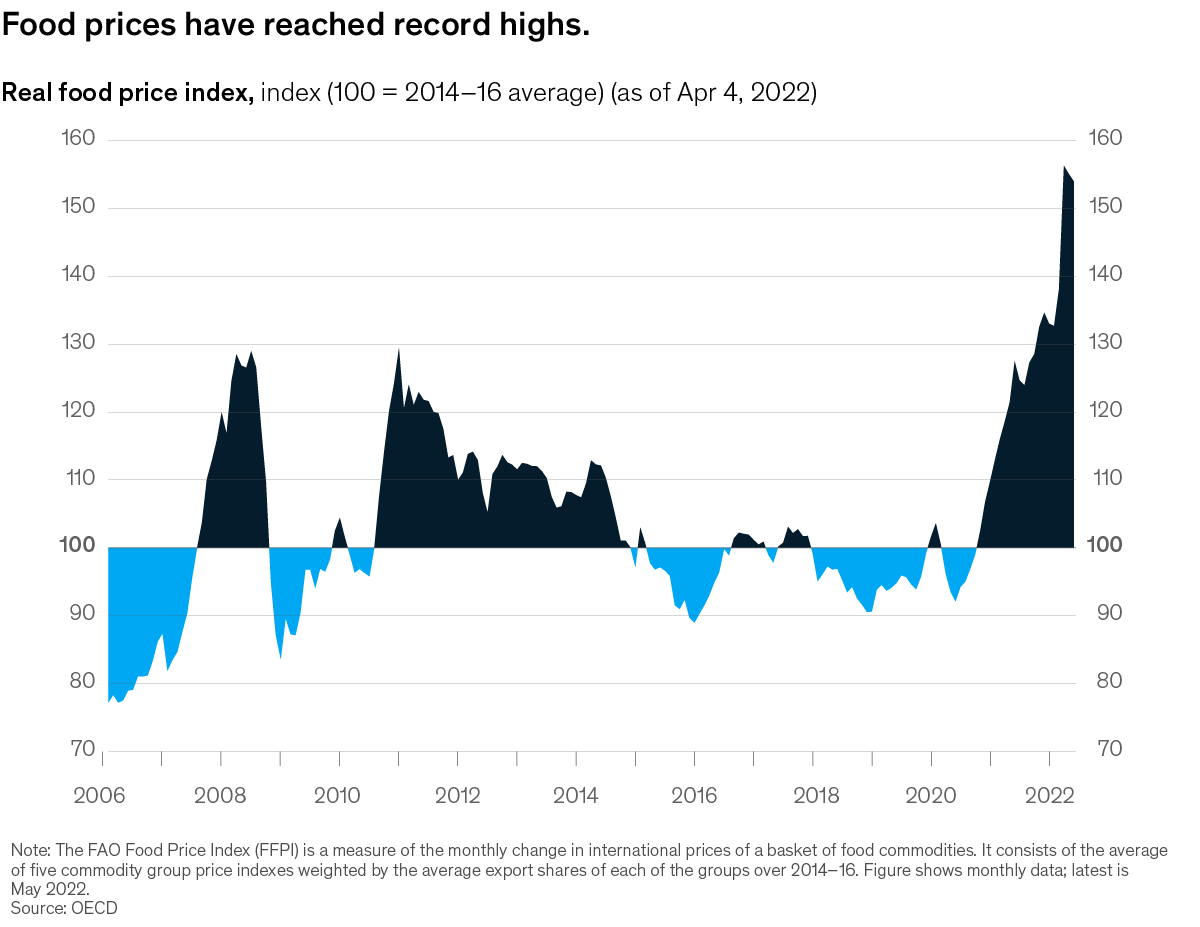
See today’s chart 
Also New 

Black beauty brands and consumers: Where do we go from here? Inequity is rife in the beauty industry, says a new McKinsey report. Ulta Beauty CEO Dave Kimbell and two of the report’s authors discuss how to better support Black brands and serve Black consumers. Pay attention 


Scaling textile recycling in Europe—turning waste into value Fiber-to-fiber recycling at scale could be achieved by 2030, creating a new and sustainable circular industry in Europe. Reuse and recycle 


McKinsey for Kids: Space Junk—it’s out of this world Rockets, satellites, moonwalks and more: let’s explore space in this seventh edition of McKinsey for Kids. Find your flight suit and buckle up for a closer look at the future of space and how people are trying to deal with the stratospheric equivalent of your family’s junk drawer. Up up and away 


Follow our thinking 



Share these insights Did you enjoy this newsletter? Forward it to colleagues and friends so they can subscribe too.
Was this issue forwarded to you? Sign up for it and sample our 40+ other free email subscriptions here.This email contains information about McKinsey’s research, insights, services, or events. By opening our emails or clicking on links, you agree to our use of cookies and web tracking technology. For more information on how we use and protect your information, please review our privacy policy. You received this email because you subscribed to the Daily Read newsletter. Manage subscriptions | Unsubscribe Copyright © 2022 | McKinsey & Company, 3 World Trade Center, 175 Greenwich Street, New York, NY 10007
by "McKinsey Daily Read" <publishing@email.mckinsey.com> - 06:19 - 19 Jul 2022 -
SmartBus - Managing School Buses and Student Transport
SmartBus - Managing School Buses and Student Transport

 SmartBus is our school bus monitoring software solution. It is an application suite consisting of the SmartBus Manager app, the SmartBus Parent app, the SmartBus driver app.
SmartBus is our school bus monitoring software solution. It is an application suite consisting of the SmartBus Manager app, the SmartBus Parent app, the SmartBus driver app.
SmartBus offers a variety of tools and reports to better understand driving behaviors. You can install driver-facing dash cams to see what your drivers are doing. You can also set customized driving alerts for harsh acceleration, braking, and excessive speeding. All these alerts get reflected on driver scorecards. Review all driver-related reports to identify high-risk drivers.
Book a Free Demo 
Download the E-Book Now  Please spare a moment and familiarize yourself with our latest platform enhancements.
Please spare a moment and familiarize yourself with our latest platform enhancements.Click to Read Full Article 




Want to change how you receive these emails?
You can update your preferences or unsubscribe from this list.
by "Uffizio Technologies Pvt Ltd" <official@uffizio.in> - 09:14 - 19 Jul 2022 -
Where are you most seeing inflation? McKinsey experts parse the latest data.
McKinsey&Company
A world united—by inflation .

Up, up, and away In the news • The (rising) price of beauty. Looking a little shaggy? Spiffing up with a haircut in the US will cost you 6.2% more than last year. That’s the biggest annual increase since 1982, but some hairdressers have hiked the tab by far more. Soaring salon bills reflect higher costs of rent and labor; they are an expense American consumers cannot skirt by buying from overseas. This is why some economists see haircut prices as a sign of entrenched domestic inflation. [WSJ] • A common concern. The world doesn’t agree on much, but it’s come together over one big source of anxiety: inflation. For the third consecutive month, inflation is the most-cited worry in a global survey, identified as a top concern by 37% of respondents in 27 countries. In general, economic issues weigh heavily on minds around the world. Next to inflation, the second biggest worry is poverty and social inequality, followed by unemployment, finds the survey of about 19,000 adults. [WEF] 
Food prices today are considerably higher than in past surges in 2008 and 2011, which were precipitated by the turmoil of the global financial crisis. 
On McKinsey.com • Silent tax makes noise. In the past six months, surging inflation has more than doubled projections in many countries, with Europe particularly affected. Inflation in Poland is at 11% and UK inflation is at 9%, both well above projections. However, Asia is seeing a more moderate change, with inflation remaining muted in China and Japan. Real wages are creeping higher in some of the world’s largest economies, but the rising tide of inflation is eroding purchasing power. • Pinning down rising costs. In many economies, prices for food and commodities have risen sharply. A spike in fertilizer prices, along with other fallout from the war in Ukraine, has pushed prices for basic foods much higher. Meanwhile, the outlook for growth for most G-20 economies has moved in the opposite direction—with one notable exception. From rising lending rates to the soaring cost of housing, see how inflation is affecting every part of the global economy in seven charts. — Edited by Katy McLaughlin Understand inflation 
Was this forwarded to you? Sign up here. Or send us feedback — we’d love to hear from you. 

Follow our thinking 


This email contains information about McKinsey’s research, insights, services, or events. By opening our emails or clicking on links, you agree to our use of cookies and web tracking technology. For more information on how we use and protect your information, please review our privacy policy. You received this email because you subscribed to the On Point newsletter. Manage subscriptions | Unsubscribe Copyright © 2022 | McKinsey & Company, 3 World Trade Center, 175 Greenwich Street, New York, NY 10007
by "McKinsey On Point" <publishing@email.mckinsey.com> - 12:54 - 19 Jul 2022 -
Space out with the latest McKinsey for Kids
the Daily read
Up, up, and away .
Share this email 



AN ARTICLE A DAY, PICKED BY OUR EDITORS 
You may have seen the stunning new images captured by the James Webb Space Telescope last week. Space is an endlessly fascinating topic, and there is a lot of excitement and activity surrounding it, especially in recent years. While satellites have helped make important advancements in space exploration and in our everyday lives, did you know that they are also giving way to more space junk—objects, paint flecks, or pieces of inactive satellites and rockets that remain in space? The latest edition of McKinsey for Kids delves deeper into the future of space, explains ways to help safely deal with its junk, and offers fun factoids, interactive components, and cool graphics. Whether you’re a space aficionado or have a passing curiosity about space, there is something for everyone. — Joyce Yoo, digital editor, New York 
McKinsey for Kids: Space Junk—it’s out of this world Rockets, satellites, moonwalks and more: let’s explore space in this seventh edition of McKinsey for Kids. Find your flight suit and buckle up for a closer look at the future of space and how people are trying to deal with the stratospheric equivalent of your family’s junk drawer. Over the moon 

Quote of the Day “We’re not in elderhood, we’re in furtherhood. We keep going further, and we have more to look forward to. This can be the happiest time of life and one of the most productive times of life, rather than an ending stage that goes on for a long period.” —Susan Wilner Golden, a lecturer at the Stanford Graduate School of Business on marketing to members of the 60-plus crowd in a recent Author Talks interview 
Chart of the Day See today’s chart 
Also New 

You’re invited Join us for a session on Human capital at work: Implications for Asia-Pacific, on Thursday, July 21, at 07:30am IST/9:00am JST/10:00am SGT/12:00 SYD. Register now 


Self-learning: The dawn of a new biomedical R&D paradigm Science and technology are driving breakthroughs at each stage of the biomedical R&D value chain. Enhancing feedback loops among them could unleash a self-learning model that would benefit patients. Gain insight 


The Great Attrition is making hiring harder. Are you searching the right talent pools? People keep quitting at record levels, yet companies are still trying to attract and retain them the same old ways. New research identifies five types of workers that employers can reach to fill jobs. Reassess now 


Follow our thinking 



Share these insights Did you enjoy this newsletter? Forward it to colleagues and friends so they can subscribe too.
Was this issue forwarded to you? Sign up for it and sample our 40+ other free email subscriptions here.This email contains information about McKinsey’s research, insights, services, or events. By opening our emails or clicking on links, you agree to our use of cookies and web tracking technology. For more information on how we use and protect your information, please review our privacy policy. You received this email because you subscribed to the Daily Read newsletter. Manage subscriptions | Unsubscribe Copyright © 2022 | McKinsey & Company, 3 World Trade Center, 175 Greenwich Street, New York, NY 10007
by "McKinsey Daily Read" <publishing@email.mckinsey.com> - 06:24 - 18 Jul 2022 -
What really motivates people to grow and change? A leader’s guide
Harmony Internal - McKinsey
Psychologically speaking 
Edited by Rama Ramaswami
Senior Editor, New YorkThe theory of self-determination holds that people are motivated to grow and change when three innate psychological needs—autonomy, competence, and relatedness or connection—are fulfilled. Applying this concept in the workplace may be the next frontier for companies seeking to retain talent. Organizations have run employee physical-fitness programs for decades and, in recent years, have begun to pay serious attention to mental-health issues. The stresses of COVID-19—such as workers’ feelings of isolation and burnout—have given rise to a slew of employer-sponsored mental-health programs, as well as to benefits such as flexible work arrangements. But as people continue to leave the workplace in record numbers, leaders may need to improve workers’ job satisfaction by focusing on their psychological well-being. Here are some ideas and strategies to think about.
AN IDEA
That really isn’t as difficult as it sounds. Most people, regardless of their income level or occupation, rate having an “interesting” job at least as important as having a high income. But organizations tend to cater more to the psychological needs of higher earners, who are likely to be managers and professionals. Meeting the psychological needs of employees in lower-paying, routine, or repetitive jobs such as clerical work or machine operation could enhance their job satisfaction, productivity, and loyalty to the organization. This may not work in all cases: for example, it could be challenging to redesign a machine operator’s job to make production line tasks less repetitive. But simple steps such as recognizing mastery of a skill or granting frontline workers discretion to make appropriate decisions can go a long way toward making jobs more psychologically satisfying for lower earners.
A BIG NUMBER
That’s the percentage of American workers who say they are in ‘good’ jobs, as defined by their satisfaction with the job characteristics they value the most. These include not only good wages and benefits but also factors unrelated to pay, such as enjoyment of their day-to-day work, having a sense of purpose at work, and having the power to change things that don’t satisfy them. An attractive pay package does get people in the door. Once they are in, though, leaders will need to provide opportunities for advancement and skill development, as well as restructure jobs wherever possible to avoid employee boredom and job dissatisfaction.
A QUOTE
That’s from psychology professor Julia Boehm, whose research examines the correlation between positive feelings and improved cardiovascular health. Even if people don’t exhibit symptoms of depression, stress, or anxiety in the workplace, they may not be functioning optimally: it’s essential for leaders to proactively enable employees to thrive. The American Psychological Association (APA) suggests several tactics that go beyond minimum mental-health offerings. For example, instill a sense of belonging for employees of all backgrounds, institute unconscious bias training, and make sure that workers take paid time off to recover from stress. According to the APA, “Encouraging employees to carve out time for their well-being not only protects their mental health but can also improve job performance.”
A SPOTLIGHT INTERVIEW
Whether you approach it through mindfulness, meditation, or building a sense of community, psychological well-being has become critical to succeeding in the workplace. In this interview with McKinsey, former Medtronic CEO and Harvard Business School professor Bill George shares his views on how to create, protect, and expand well-being within our teams and in our lives. “As a leader, you want to give encouragement to the people you work with to bring their ideas forth, to be real people, to be authentic and to be mindful and to have their own practices and give them the opportunity to do that,” he says. Take the time to engage with people authentically and with humanity, George advises. “Make everyone at your organization feel like, ‘This is my home. This is where I want to be, and you respect me for who I am.’”
PICK A NUMBER
Does a big paycheck guarantee happiness? Scientists have long debated this question—and the jury’s still out. A well-known study conducted in 2010 found that happiness leveled off once household income topped $75,000 a year. More recent research has upped that number to $95,000, although that’s for overall “life satisfaction”; the price of day-to-day well-being comes in at $60,000 to $75,000. And it is possible to make too much money: happiness levels decline once you earn more than $105,000. To make things more confusing, new research from 2021 suggests that the more money people make, the happier they become. For leaders trying to make sense of it all, the focus should be on developing nonmonetary rewards that motivate workers to look beyond a paycheck.
Lead by supporting well-being.
Share these insights
Did you enjoy this newsletter? Forward it to colleagues and friends so they can subscribe too. Was this issue forwarded to you? Sign up for it and sample our 40+ other free email subscriptions here.
This email contains information about McKinsey's research, insights, services, or events. By opening our emails or clicking on links, you agree to our use of cookies and web tracking technology. For more information on how we use and protect your information, please review our privacy policy.
You received this email because you subscribed to the Leading Off newsletter.
Copyright © 2022 | McKinsey & Company, 3 World Trade Center, 175 Greenwich Street, New York, NY 10007
by "McKinsey Leading Off" <publishing@email.mckinsey.com> - 03:46 - 18 Jul 2022 -
As more companies pursue automation, what new skills will workers need?
McKinsey&Company
Your questions about automation, answered .

Automate it In the news • Turning to robotics. Booming e-commerce, persistent worker shortages, and a vulnerable supply chain have led to surging investment in automating logistics. Retailers are spending billions on robotic arms, autonomous vehicles, and collaborative robots to speed operations in warehouses across the US. The movements of one humanoid robot, designed to perform warehouse tasks such as unloading boxes, was based on studying walking birds. Businesses are increasingly turning to automation as technology costs have come down. [NYT] • Filling in the blanks. Software developers are among the most desired tech workers in the US, with more than 200,000 job openings in May. Much of their work is done manually, but a new tool powered by AI aims to take some of the tedium out of writing long lines of computer code. By predicting and filling in lines of code—similar to the predictive-text function on a smartphone—the coding bot can cut in half the amount of time it takes to develop an app. [WSJ] 
Automation technologies are being adopted globally: more than six in ten respondents in each region report at least piloting automation. 
On McKinsey.com • Growing adoption. In every region of the world, a growing share of companies are adopting automation technologies, find senior partner Rohit Sood and colleagues in our latest McKinsey Global Survey. Seventy percent of respondents say their companies are at least piloting automation in one or more business units or functions, up from 66% in 2020. But few are reaping the full potential of automation: less than one-fifth of respondents report that their organizations have already scaled automation technologies across much of the business. • Changing skills. Survey responses show that the most common reasons for automating are to improve business processes’ effectiveness and to create better experiences for customers or employees. Respondents report many benefits from automation, including increased customer satisfaction. But as more tasks are automated, organizations will need workers with more advanced cognitive skills like critical thinking. Learn where successful companies are focusing their automation efforts, and what tools and technologies are most commonly used. — Edited by Belinda Yu Succeed at automation 
Was this forwarded to you? Sign up here. Or send us feedback — we’d love to hear from you. 

Follow our thinking 


This email contains information about McKinsey’s research, insights, services, or events. By opening our emails or clicking on links, you agree to our use of cookies and web tracking technology. For more information on how we use and protect your information, please review our privacy policy. You received this email because you subscribed to the On Point newsletter. Manage subscriptions | Unsubscribe Copyright © 2022 | McKinsey & Company, 3 World Trade Center, 175 Greenwich Street, New York, NY 10007
by "McKinsey On Point" <publishing@email.mckinsey.com> - 12:40 - 18 Jul 2022 -
What’s next in video entertainment?
McKinsey&Company
Watch this space .
Share this email 



New from McKinsey & Company What’s next in video entertainment? Picture this: You’re at the movies with friends—but the movie is more like a game with a narrative. You feel like you’re in the movie because your seat gets hot when there’s a fire on screen. And everyone can see and hear the movie in whatever language they choose. That scenario could represent the future of video entertainment: immersive, gamified, and diverse. Check out the latest edition of The Next Normal to see what and how you’ll watch tomorrow, and dive deeper with these insights. Read more 

Video entertainment in 2030 McKinsey experts predict that video entertainment, in all its forms, will become more immersive, gamified, and personalized. Immerse yourself 


Game on: An interview with Microsoft’s head of gaming ecosystem Sarah Bond discusses how Microsoft shifted its console-centric gaming business to make the most of its investments in cloud. Game on 
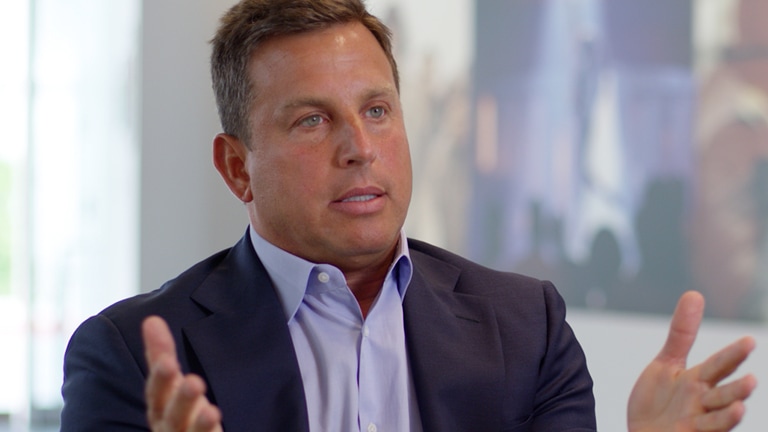

The future of streaming and diverse content: Starz CEO Jeffrey Hirsch weighs in What technology means for the future of streaming, why most shows will be borderless, and how inclusive programming has been so good for business. Take the lead 


The data-driven future of storytelling: MIT’s Deb Roy on the message and the medium The head of MIT’s Center for Constructive Communication talks about how data can help storytellers, what audiences of the future might look like, and why artificial intelligence cannot replace human creativity. Understand the future of media 


Stacey Sher on the future of movies and streaming The veteran film and TV producer shares her perspective on what the technology shifts roiling the entertainment business mean for both artists and audiences. Look forward 


Black representation in film and TV: The challenges and impact of increasing diversity New research reveals the barriers that Black talent in the film and TV industry faces, the economic fallout, and solutions for creating a more inclusive, equitable workplace. Take concerted action 


Value creation in the metaverse With its potential to generate up to $5 trillion in value by 2030, the metaverse is too big for companies to ignore. Enter the metaverse 


The Netflix of gaming? Why subscription video-game services face an uphill battle Many tech giants are betting that the subscription model will become dominant in video games. Yet the things that make gaming such an entertainment dynamo are problematic for these types of services. Understand the characteristics 
To see more essential reading on topics that matter, visit McKinsey Themes. — Curated by Eleni Kostopoulos, a digital publishing manager based in New York 

Follow our thinking 


McKinsey Insights - Get our latest
thinking on your iPhone, iPad, or Android


Share these insights Did you enjoy this newsletter? Forward it to colleagues and friends so they can subscribe too.
Was this issue forwarded to you? Sign up for it and sample our 40+ other free email subscriptions here.This email contains information about McKinsey’s research, insights, services, or events. By opening our emails or clicking on links, you agree to our use of cookies and web tracking technology. For more information on how we use and protect your information, please review our privacy policy. You received this email because you subscribed to The Next Normal newsletter list. Manage subscriptions | Unsubscribe Copyright © 2022 | McKinsey & Company, 3 World Trade Center, 175 Greenwich Street, New York, NY 10007
by "McKinsey & Company" <publishing@email.mckinsey.com> - 05:06 - 16 Jul 2022 -
The week in charts
the Daily read
Economic pessimism, electric cars, and more .
Share this email 



ALL THE WEEK’S DATA THAT'S FIT TO VISUALIZE 
Our Charting the path to the next normal series offers a daily chart that helps explain a changing world—as we strive toward sustainable and inclusive growth. In case you missed them, this week’s graphics explored economic pessimism, electric cars, the future of the fashion industry, inflation concerns, and decarbonizing the food system. FEATURED CHART Gloomy economic view 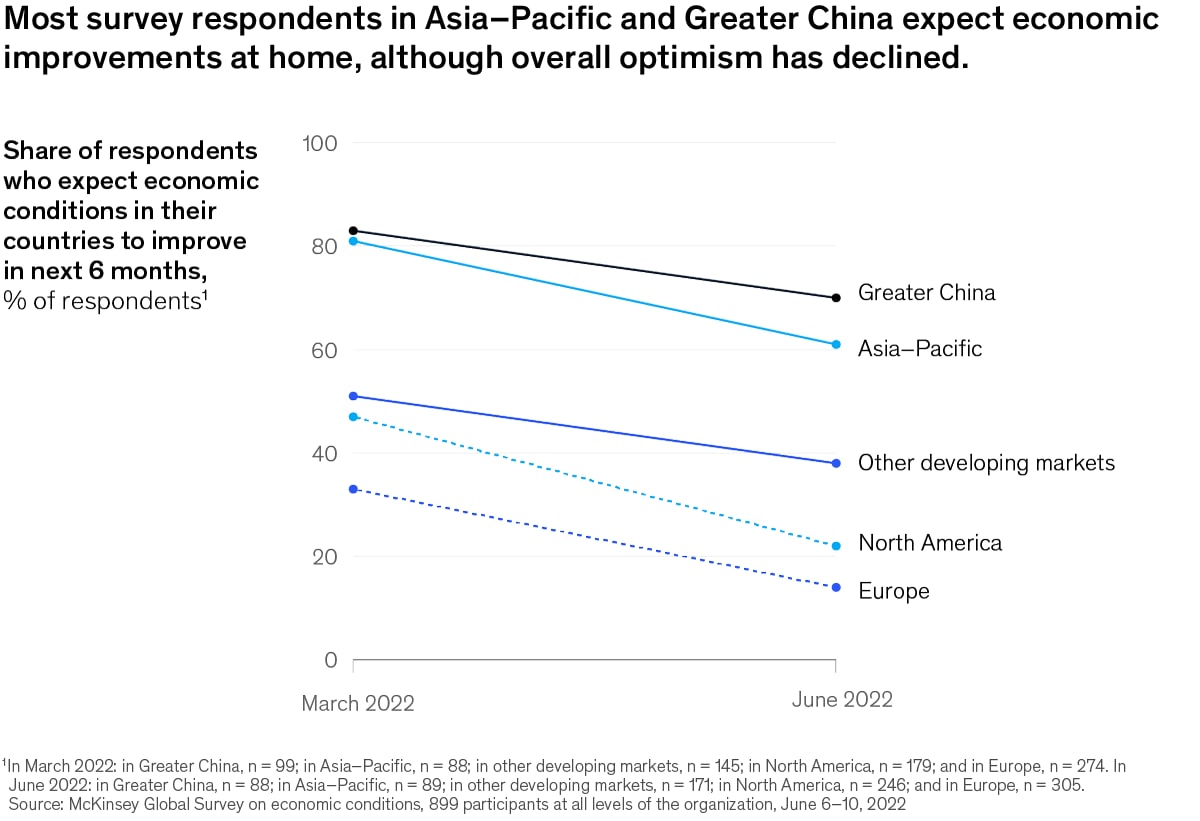
See more 



This week’s other select charts Solving for net zero Fashion doubles down on tech Shifting concerns for European consumers Greening grocers 

Follow our thinking 



Share these insights Did you enjoy this newsletter? Forward it to colleagues and friends so they can subscribe too.
Was this issue forwarded to you? Sign up for it and sample our 40+ other free email subscriptions here.This email contains information about McKinsey’s research, insights, services, or events. By opening our emails or clicking on links, you agree to our use of cookies and web tracking technology. For more information on how we use and protect your information, please review our privacy policy. You received this email because you subscribed to The Week in Charts newsletter. Manage subscriptions | Unsubscribe Copyright © 2022 | McKinsey & Company, 3 World Trade Center, 175 Greenwich Street, New York, NY 10007
by "McKinsey Week in Charts" <publishing@email.mckinsey.com> - 03:34 - 16 Jul 2022 -
How the best organizations manage talent
McKinsey&Company
Selection, recruitment, development, and rewards .
Share this email 



McKinsey Classics | July 2022 
How the best organizations manage talent A decade ago, a McKinsey study of R&D laboratories found that many of them didn’t really know if their productivity was good, bad, or indifferent, mainly because researchers tend to overrate themselves—70 percent claimed that their labs were at least in the top quarter for productivity. Don’t work in one? Substitute “organization” for lab and “executive” or “employee” for researcher. Such illusions can develop anywhere, and the path to improvement is essentially the same. The best labs, our study discovered, know how to manage talent. That may not mean hiring the best—not every organization can—but rather managing researchers effectively through selection, recruitment, development, and rewards. Average labs, for instance, typically hire people with specific technical proficiencies. Top ones want curious scientists who can adapt to new roles. Top labs reward the work of high performers (particularly by giving them better assignments) and explicitly link financial rewards to performance. Many weak labs simply move underperformers to other facilities. The best try to help people improve and encourage those who don’t to move on, which can make room for new researchers and therefore help build diverse, high-performing teams. So does encouraging rotation to other research areas and geographies. Of the practices that influence an organization’s productivity, talent management is often the one most in need of improvement. Read our 2011 classic “How the best labs manage talent.” — Roger Draper, editor, New York Improve your teams’ productivity 



Related Reading 
The Great Attrition is making hiring harder. Are you searching the right talent pools? 

Meet the psychological needs of your people—all your people 

Strategic talent management for the postpandemic world 

Did You Miss Our Previous McKinsey Classics? 

The risk function of the future To learn about the most important trends in risk and how companies can respond to them, read “The future of bank risk management.” Learn how companies will manage risk 





Follow our thinking 


McKinsey Insights - Get our latest
thinking on your iPhone, iPad, or Android

This email contains information about McKinsey’s research, insights, services, or events. By opening our emails or clicking on links, you agree to our use of cookies and web tracking technology. For more information on how we use and protect your information, please review our privacy policy. You received this email because you subscribed to our McKinsey Classics newsletter. Manage subscriptions | Unsubscribe Copyright © 2022 | McKinsey & Company, 3 World Trade Center, 175 Greenwich Street, New York, NY 10007
by "McKinsey Classics" <publishing@email.mckinsey.com> - 11:28 - 16 Jul 2022 -
MD, last chance to let us know your opinion. don’t miss out!
MD, last chance to let us know your opinion. don’t miss out!
Hello MD
This is the last chance to let your opinion be heard. Remote launched a Global Benefits Survey to better understand hiring remotely in other countries and the importance of benefits.
This is your last chance to be heard, to receive a summary of this research, and to enter to win an iPad Air (5th generation).
If you haven’t done so already, please take a few minutes to fill out this survey.Thank you for sharing your insights!
Your Remote Team
You've got questions?
We've got answers.
Save time with 24/7 access to Remote’s Help Center.
You received this email because you are subscribed to News & Offers from Remote Technology, Inc.
Update your email preferences to choose the types of emails you receive.
Unsubscribe from all future emailsRemote Technology, Inc.
Copyright © 2022 Remote Technology, Inc. All rights reserved.
18 Bartol St. #1163 San Francisco California
by "Remote" <hello@remote-comms.com> - 08:30 - 15 Jul 2022 -
The quitting trend just won’t quit. It’s time for companies to update their talent strategy.
The Shortlist
Pay and perks won’t do it anymore .
Share this email 



Our best ideas, quick and curated | JULY 15, 2022 View in browser 
This week, why companies are still having such a hard time adjusting to the new labor market, and what new research tells us they can do to fill all the open jobs out there. Plus, an interview with Stacey Sher about the future of movies and streaming, and five trends in the luxury-car market. 
It’s still quitting time. Much has changed in the business world since early 2020, but one trend has remained constant: people keep leaving their jobs in droves. In fact, 40 percent of workers McKinsey recently surveyed say they’re thinking about leaving their positions in the next three to six months. That widespread disgruntlement is the same as 2021 levels. But it’s not just about quitting. Workers are also switching jobs and industries, moving from traditional to nontraditional roles, retiring early, or starting their own businesses. They’re taking a time-out to tend to their personal lives or embarking on sabbaticals. Call it the Great Attrition, the Great Resignation, or the Great Reshuffling; any way you slice it, competition for talent remains fierce. At the current and projected pace of hiring, quitting, and job creation, openings likely won’t return to previous levels for some time. Organizations are going to be looking to fill roles for months to come, even if the economic outlook darkens. New views of work. “The Great Attrition is making hiring harder. Are you searching the right talent pools?” reveals that many workers no longer want a traditional position with traditional pay and perks. This new research—including a survey of more than 13,000 respondents in six countries—shows that many people are reevaluating what they want from a job (and from life), and they’re looking for something more, less, or different. Employees frequently cite the feeling of always being on call, unfair treatment, unreasonable workload, low autonomy, and lack of social support as things undermining their well-being. They want more flexibility, more mental-health support, and more meaningful work. Companies are addressing these problems, to be sure, but they’re still coming up short. Different talent pools. A central problem is that organizations keep trying to hire “traditionalist” workers using the same tried-and-true methods. Instead, they have to look in different talent pools, including people who have retired but might go back to work for the right situation. McKinsey’s research delves into five different employee profiles, or personas, to offer companies a new way of looking at the workforce. We broke them down into traditionalists, idealists, do-it-yourselfers, and others. These groups show that companies have to get more creative with their employee value proposition to solve this attrition problem for the longer term. 
OFF THE CHARTS Ramping up recycling As interest in the circular economy grows, emerging recycling technologies are accelerating. Advanced recycling offers one potential solution to the increasing demand for circular polymers by expanding the types of plastics that can be recycled, allowing for the creation of polymers that can be reformed and reused. If existing constraints were resolved, advanced recycling could grow to 20 million to 40 million metric tons, providing investment opportunities of more than $40 billion. 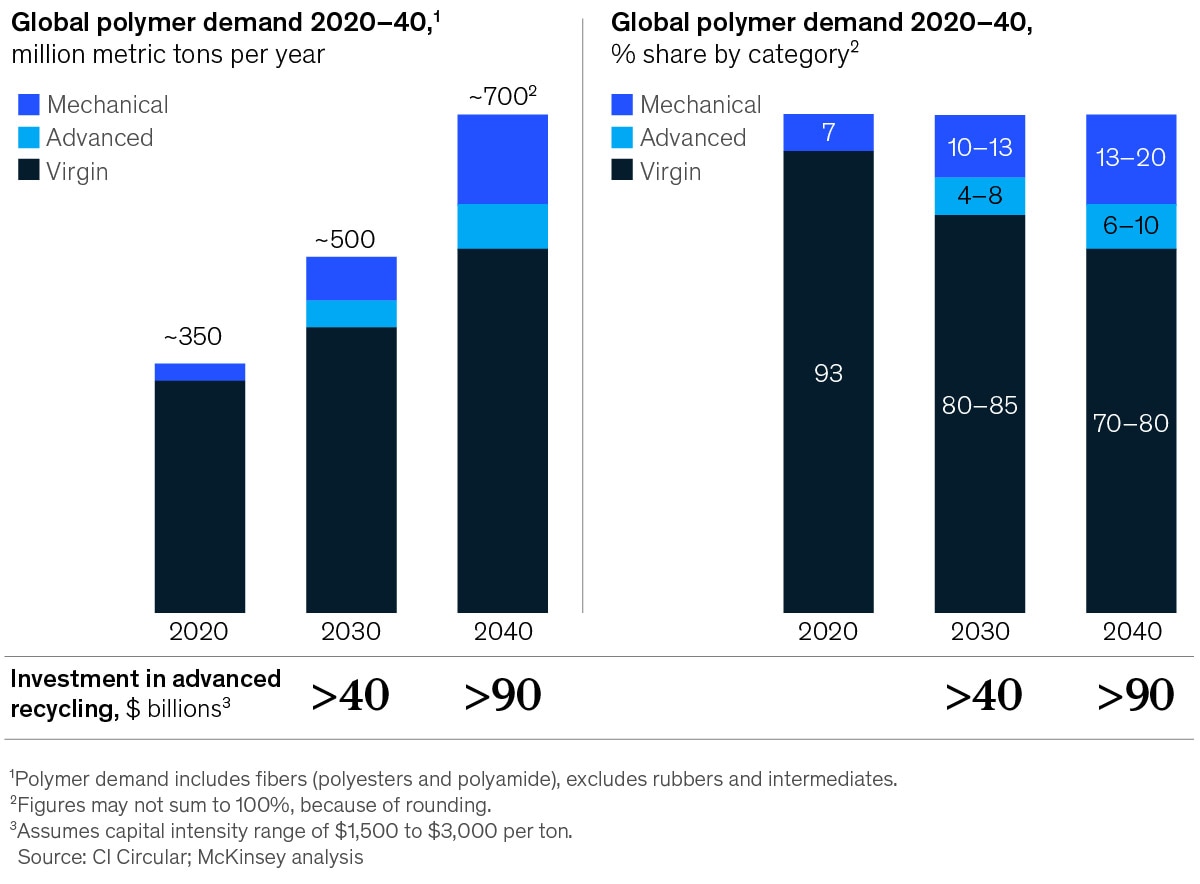
Check out our chart of the day here. 

INTERVIEW Artists and audiences in the streaming era Stacey Sher, the producer of acclaimed films such as Pulp Fiction and Erin Brockovich, has had a front-row seat to the rise of streaming and its effect on how stories are told and consumed. In a conversation with McKinsey about the evolution of film and TV, she spoke about the postpandemic outlook for the moviegoing experience, the excitement of storytelling opportunities in streaming, and much more. “We’re in a time of flux, in a time of change, and what was on its way toward being broken is being broken in a different way,” she said. 
MORE ON MCKINSEY.COM Five trends shaping the luxury-car market | Sales of luxury cars continue to surpass the mass market in growth, profitability, and buzz. Here are five developments that will shape the luxury market over the coming decade. Game on | Video entertainment, in all its forms, will become more immersive, gamified, and personalized by 2030. Four McKinsey experts imagine the future. Customer care in 2022 | Customer experience is more important than ever—yet it has never been more challenging as companies face a perfect storm of increasing call volumes, talent shortages, and rising customer expectations. 


WHAT WE’RE THINKING Jennifer Spaulding Schmidt Jennifer Spaulding Schmidt, a senior partner in the Minneapolis office, works with global consumer companies on large transformation programs and growth strategies. She also leads McKinsey’s apparel, fashion, and luxury work in the Americas. Companies across sectors continue to struggle with supply chain challenges. One of the most counterintuitive approaches I have seen comes from an apparel retailer, whose solution is to turn competitors into collaborators and customers. Most brick-and-mortar retailers are still catching up with the massive shift to e-commerce, which has accelerated during the COVID-19 pandemic and may well account for a third of all retail sales by 2030. When you’ve built an extensive network of stores, shifting to a business model in which you receive half of your sales from an online channel is a structural challenge. Suddenly, the old approach—all of your inventory landlocked in a distribution center in the middle of the country—doesn’t make operational sense. Many retail chains started dealing with this problem a few years ago by shifting significant inventory to their stores—in effect, turning them into mini e-commerce order fulfillment centers. This model works when orders contain only one item that is close to the person who made the purchase. In most retail operations, the cost to pack a single item during downtime is seen as acceptable. But retailers have learned that orders typically contain two or three (or more) items that usually aren’t available in the same location. The cost of paying multiple salespeople to pick and pack an order—as well as the extra shipping costs for that multiitem order—adds up quickly. Making matters worse, forward-deploying inventory to hundreds or thousands of locations makes it harder for retailers to keep up with unpredictable customer demand, which is something of the norm in fashion. This apparel retailer decided it could do better by restructuring its supply chain. It opened more than a half dozen smaller fulfillment centers. The centers provided practically all the inventory that the retailer’s stores and online customers needed and could deliver it in a hurry. By replicating a model more common in fast-moving, highly predictable consumer goods, this retailer reduced online order costs by 15 percent per order. The company also slashed working capital by pulling seven weeks of inventory from stores and selling more goods at full price, since it didn’t have to mark down items stranded in stores. This is where the story takes an interesting twist. Once the retailer saw how well its new supply chain network was working, it realized that it had landed on a possible new business. Nearly all of its competitors faced the same problem and a future of supply chain costs accelerating faster than revenues. Why couldn’t the retailer apply its new expertise to a cooperative model that provided the scale benefits and inventory balancing that only the largest big-box retailers could normally achieve? The math suggested that the retailer would need 250 businesses of its own size to match the scale economies of the larger multicategory retailers. Could it further evolve the model with technology, robotics, and analytics to offer supply chain as a service to its competitors? It’s early days still, but the answer seems to be yes. This retailer bought two online logistics companies that had helped it establish the network and found ways to aggregate orders from different businesses to save parcel costs. The net result is $1 in savings per order, which is meaningful for midmarket retailers. It’s a frenemy strategy that encourages and creates incentives for open-source collaboration among competitors. By now, many of us take online ordering and speedy delivery for granted. But I believe that their continued acceleration will roil the retail industry for a long time to come, even when the pandemic is a distant memory. — Edited by Barbara Tierney Share this What We’re Thinking 



BACKTALK Have feedback or other ideas? We’d love to hear from you. 
Tell us what you think 

Follow our thinking 



Share these insights Did you enjoy this newsletter? Forward it to colleagues and friends so they can subscribe too.
Was this issue forwarded to you? Sign up for it and sample our 40+ other free email subscriptions here.This email contains information about McKinsey’s research, insights, services, or events. By opening our emails or clicking on links, you agree to our use of cookies and web tracking technology. For more information on how we use and protect your information, please review our privacy policy. You received this email because you subscribed to The Shortlist newsletter. Manage subscriptions | Unsubscribe Copyright © 2022 | McKinsey & Company, 3 World Trade Center, 175 Greenwich Street, New York, NY 10007
by "McKinsey Shortlist" <publishing@email.mckinsey.com> - 02:37 - 15 Jul 2022 -
Some companies succeed, while others stagnate. What actions make a difference?
McKinsey&Company
Five mindsets shared by growth leaders .

Get growing In the news • Strong headwinds. Businesses around the world are facing strong headwinds: the energy crisis, record-high inflation, rising interest rates, and the return of lockdowns in Asia. Some UK companies are already bracing for a possible recession. As consumers tighten their belts, businesses that depend on discretionary spending (such as travel and leisure) may be especially vulnerable. Households cutting back on discretionary spending could also hurt retailers in the US, where some big-box stores have already warned of falling profits. [FT] • US stocks slide. Wall Street wrapped up its worst first half of the year since 1970, with US stocks losing trillions of dollars in value. One major US stock market index has fallen nearly 20% since early 2022. But things could get bumpier still. In a recession, corporate profits usually decline by a quarter, and even a mild downturn could see earnings fall by 15%. If interest rates keep rising, the market could be facing a blow to earnings and higher interest rates later this year. [Bloomberg] 
Growth leaders generate 80% more shareholder value than their peers over a ten-year period. 
On McKinsey.com • Beating the odds. Many leaders aspire to grow their businesses, but for many, that goal may seem difficult to achieve. Only one in eight companies grew their revenues more than 10% in the decade between 2010 and 2019, a McKinsey analysis revealed. Moreover, about 25% of companies don’t grow at all. But delivering sustained, profitable growth—even in a downturn—is possible. In fact, many high-growth companies, including Airbnb, Burger King, Hyatt Hotels, and Microsoft, were founded during an economic downturn. • Five mindsets. C-suite leaders who outperform their peers often share common mindsets, exemplified by statements such as “I have a growth story I tell all the time,” “I am willing to fail,” and “I favor timely action over perfection.” In fact, leaders who adopt at least three of five key growth mindsets are more than twice as likely to profitably outgrow their peers, finds McKinsey senior partner Michael Birshan and colleagues. See our blueprint for growth, including examples of companies that have successfully expanded beyond their core businesses. — Edited by Belinda Yu Discover five growth mindsets 
Was this forwarded to you? Sign up here. Or send us feedback — we’d love to hear from you. 

Follow our thinking 


This email contains information about McKinsey’s research, insights, services, or events. By opening our emails or clicking on links, you agree to our use of cookies and web tracking technology. For more information on how we use and protect your information, please review our privacy policy. You received this email because you subscribed to the On Point newsletter. Manage subscriptions | Unsubscribe Copyright © 2022 | McKinsey & Company, 3 World Trade Center, 175 Greenwich Street, New York, NY 10007
by "McKinsey On Point" <publishing@email.mckinsey.com> - 12:38 - 15 Jul 2022 -
Forward Thinking on people, places, and the revenge of places that don’t matter with Andrés Rodríguez-Pose
McKinsey&Company
Innovate and grow .
Share this email 



New from McKinsey Global Institute 
Forward Thinking on people, places, and the revenge of places that don’t matter with Andrés Rodríguez-Pose A leading economic geographer talks regional growth and inequality, discontent and populism, innovation, migration, and development policies and strategies. Innovate and grow 


Explore this and future episodes of the McKinsey Global Institute’s Forward Thinking podcast on our site, and subscribe to ensure you never miss a new one. Subscribe via Apple Podcasts, Google Podcasts, Spotify, and Stitcher. 
Related Reading 
The Bio Revolution: Innovations transforming economies, societies, and our lives 

Explore The McKinsey Download Hub 


Follow our thinking 


McKinsey Insights - Get our latest
thinking on your iPhone, iPad, or Android

This email contains information about McKinsey’s research, insights, services, or events. By opening our emails or clicking on links, you agree to our use of cookies and web tracking technology. For more information on how we use and protect your information, please review our privacy policy. You received this email because you subscribed to our McKinsey Global Institute alert list. Manage subscriptions | Unsubscribe Copyright © 2022 | McKinsey & Company, 3 World Trade Center, 175 Greenwich Street, New York, NY 10007
by "McKinsey Global Institute" <publishing@email.mckinsey.com> - 04:10 - 14 Jul 2022 -
How can airlines navigate the latest travel surge?
McKinsey Quarterly
Get your Five Fifty .
Travel takes off Air travel is back. Here’s what airline execs need to know to help boost travel industry recovery and navigate the latest influx of fliers. 
Get your briefing 
While travel is on the rise, so are concerns about sustainability. Industry leaders should keep in mind that younger customers are especially conscious about airline emissions. 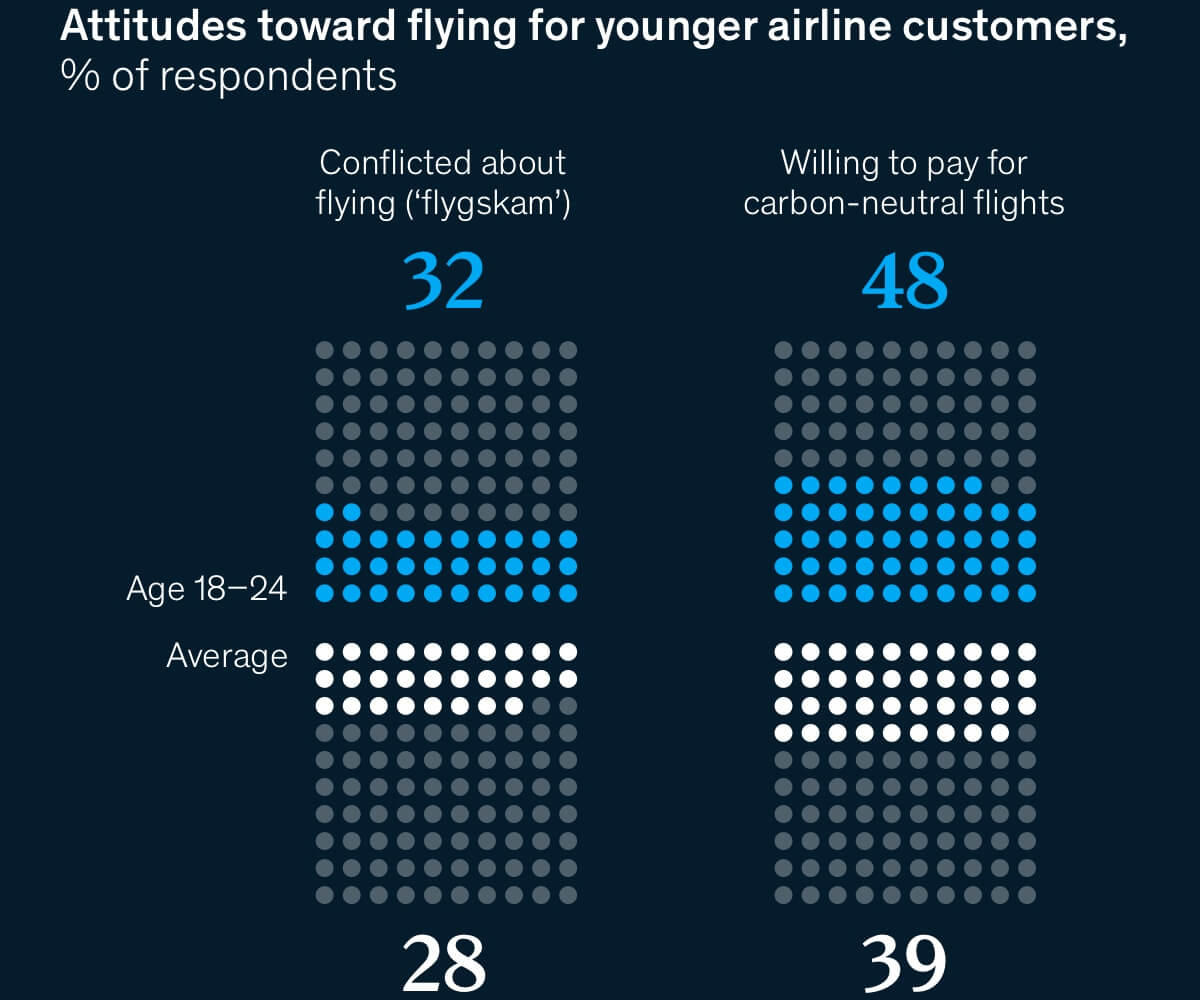

Get flying 


Follow our thinking 


This email contains information about McKinsey’s research, insights, services, or events. By opening our emails or clicking on links, you agree to our use of cookies and web tracking technology. For more information on how we use and protect your information, please review our privacy policy. You received this email because you subscribed to our McKinsey Quarterly Five Fifty alert list. Manage subscriptions | Unsubscribe Copyright © 2022 | McKinsey & Company, 3 World Trade Center, 175 Greenwich Street, New York, NY 10007
by "McKinsey Quarterly Five Fifty" <publishing@email.mckinsey.com> - 02:17 - 14 Jul 2022 -
The Great Attrition is making hiring harder. Are you searching the right talent pools?
McKinsey&Company
Reassess now .
Share this email 



New from McKinsey Quarterly 
The Great Attrition is making hiring harder. Are you searching the right talent pools? People keep quitting at record levels, yet companies are still trying to attract and retain them the same old ways. New research identifies five types of workers that employers can reach to fill jobs. Reassess now 



Related Reading 
‘Great Attrition’ or ‘Great Attraction’? The choice is yours 

Gone for now, or gone for good? How to play the new talent game and win back workers 


Follow our thinking 


McKinsey Insights - Get our latest
thinking on your iPhone, iPad, or Android


Share these insights Did you enjoy this newsletter? Forward it to colleagues and friends so they can subscribe too.
Was this issue forwarded to you? Sign up for it and sample our 40+ other free email subscriptions here.This email contains information about McKinsey’s research, insights, services, or events. By opening our emails or clicking on links, you agree to our use of cookies and web tracking technology. For more information on how we use and protect your information, please review our privacy policy. You received this email because you subscribed to our McKinsey Quarterly alert list. Manage subscriptions | Unsubscribe Copyright © 2022 | McKinsey & Company, 3 World Trade Center, 175 Greenwich Street, New York, NY 10007
by "McKinsey Quarterly" <publishing@email.mckinsey.com> - 12:04 - 14 Jul 2022 -
[Online workshop] Do more with dashboards, NRQL and custom visualizations
Take visualizations to the next level by joining this hands-on workshop that will help to elevate your dashboard skills. Build powerful dashboards to help you understand your systems, troubleshoot more efficiently, and correlate performance metrics with business KPIs.- Explore the data you collect, build custom charts, and create data-rich dashboards
- Learn about powerful dashboard features that enable you to link, filter, and share them for more powerful troubleshooting and data correlation.
Register now New Relic, Inc.
31-36 Golden Ln, Dublin 8, D08 A5RV, Ireland | +353 (01) 687 6808
Unsubscribe or change your email address and preferences at any time.
For information about our privacy practices, see our Privacy Policy.© 2022 New Relic, Inc. All rights reserved.
New Relic logo are trademarks of New Relic, In
This email was sent to info@learn.odoo.com. If you no longer wish to receive these emails, click on the following link: Unsubscribe
by "New Relic" <emeamarketing@newrelic.com> - 04:38 - 14 Jul 2022 -
As the net-zero transition unfolds, green businesses could see exponential growth.
McKinsey&Company
Seven keys to green business building .

Big green business In the news • Climate tech boom. Investment in climate technology has been strong in recent years, with climate tech start-ups raising $53.7 billion in 2021. The first part of 2022 has brought signs of a possible shift: in May, environmental, social, and governance (ESG) equity funds saw significant outflows, and venture capital funding in green tech slowed at the start of the year. Nonetheless, some industry experts think the climate tech investing trend could continue. High gas prices, the conflict in Ukraine, and net-zero pledges from corporations and countries could help sustain interest and investment in climate solutions, they say. [Bloomberg] • An MBA in climate change? Sustainability has typically been left out of core business school curriculum, but that’s starting to change. Last year, a coalition of European business schools launched a new climate leadership program, and one business school in England now offers a “One Planet MBA.” These programs seek to increase expertise in climate change and integrate sustainability into areas such as accounting, finance, and procurement. [FT] 
While it took many years to scale up renewable-electricity generation, broadening support for the net-zero agenda could enable the next wave of green businesses to grow more quickly. 
On McKinsey.com • Going green. The transition to net zero could create significant opportunities to build green businesses. Growing demand for low-emissions offerings could generate more than $12 trillion of annual sales by 2030 across 11 value pools, including transport, buildings, and power, McKinsey analysis shows. Climate technologies that propel the net-zero transition, particularly ones that are not yet at commercial scale (such as green-hydrogen-based fuels or industrial electrification) could present companies with an opportunity for exponential growth. • Lessons learned. Scaling a climate technology isn’t always easy and can require moving at the speed of digital companies. Based on our experience, green business builders often set ambitious growth goals and gain advantages because they move quickly. For example, one Swedish battery manufacturer signed up supply orders from automotive companies before fully ramping up production capacity. See seven key principles to building and expanding a green business. — Edited by Andrew Simon Accelerate to net zero 
Was this forwarded to you? Sign up here. Or send us feedback — we’d love to hear from you. 

Follow our thinking 


This email contains information about McKinsey’s research, insights, services, or events. By opening our emails or clicking on links, you agree to our use of cookies and web tracking technology. For more information on how we use and protect your information, please review our privacy policy. You received this email because you subscribed to the On Point newsletter. Manage subscriptions | Unsubscribe Copyright © 2022 | McKinsey & Company, 3 World Trade Center, 175 Greenwich Street, New York, NY 10007
by "McKinsey On Point" <publishing@email.mckinsey.com> - 10:10 - 13 Jul 2022 -
How supply chains can become greener
Re:think
Decarbonization boosts resilience With supply chain disruptions now a fact of life for many companies, resilience has become the top priority for business leaders. One critical aspect deserves more attention: decarbonization. Juggling cost, resilience, and decarbonization may sound challenging, but these elements can work hand in hand.
Decarbonized supply chains are ultimately more resilient supply chains—and may even unlock the way to cheaper supply chains in the coming years. And shipping, which accounts for around 90 percent of ton-miles covered in global trade, is a good place to start.
Decarbonized shipping won’t fix supply chain bottlenecks such as driver shortages or a lack of warehouse space, but it can help with fuel price volatility. Improving fuel efficiency reduces exposure to wild price swings in fuel costs. Our research shows that between a third and half of decarbonization will come from greater fuel efficiency.
The adoption of zero-carbon and carbon-neutral fuels will close the remaining gap. Clean hydrogen-based fuels (including e-methanol, e-ammonia, e-methane, and hydrogen itself) may become cost competitive in ten to 20 years. Unlike the production of fossil fuels, which is concentrated in specific regions, the manufacture of hydrogen fuels is geographically diverse. After all, solar power and wind are abundant in many places. Such availability should result in a competitive landscape that lowers costs.
What’s more, the trend toward supply chain decarbonization is clear. Across industries, companies are upping their scope-3 decarbonization targets, which include reducing supply chain emissions. Many shipping companies have pledged to reach net zero by 2050. The more gung-ho ones are aiming for 2040.
Setting bold scope-3 targets now can save companies from being forced to make sudden, more expensive adjustments in the future when regulators tighten environmental standards. The International Maritime Organization is targeting, by 2050, a 50 percent reduction in absolute CO₂ emissions from 2008 levels, but many governments are pushing for shipping that is fully carbon neutral by 2050.“The potential impact of biofuels—representing a reduction in CO₂ emissions of anywhere between 25 and 60 percent—is nothing to scoff at.”
However, more needs to be done. Looking at the current policy landscape, the likely rates of improvement in ship efficiency, and the declining costs of alternative fuels and then projecting forward, we expect the global shipping industry to release about 20 percent more CO₂ between now and 2050—nowhere close to carbon zero.
The first step is for companies to add transparency into their supply chains’ carbon output. This was traditionally hard to do because of market opacity around different vessels’ fuel performance. But solutions now exist that estimate carbon emissions based on the vessels that carry goods, and new Internet of Things innovations are making emissions omniscience a reality.This visibility allows businesses to identify and seize quick wins. For a cargo owner, for example, choosing a ship that consumes 3 percent less fuel will immediately reduce CO₂ emissions by 3 percent. Plus, the cargo owner can encourage its shipping partners and their fuel providers to experiment with biofuel pilot schemes. The potential impact of biofuels—representing a reduction in CO₂ emissions of anywhere between 25 and 60 percent—is nothing to scoff at.
Naturally, the big question is making the economics work. In sectors such as consumer goods, companies may be able to spread the cost across the value chain. Customers of consumer electronics, fashion, and automobiles are unlikely to balk at miniscule price increases for greener shipping. A 20 or even 50 percent rise in shipping costs may translate to only a few extra dollars for someone buying a pair of sneakers.
What if a business is transporting commodities and can’t offload the extra cost? Even so, the company may be able to enter into arrangements with shipping partners and fuel suppliers that give it the confidence to invest in fuel-efficient technologies or cleaner fuels. Innovative commercial agreements such as buyers’ clubs and long-term take-or-pay contracts will become more common in the coming years.
Despite current supply chain disruptions, many executives haven’t lost sight of the importance of decarbonizing their supply chains. I’m encouraged that they see seismic shifts on the horizon: stricter regulations are coming, and customer demand for cleaner practices is growing. Those who don’t act now may emerge from one maelstrom only to find themselves in the troubled waters of the next one.ABOUT THE AUTHOR
Matt Stone is a partner in McKinsey’s London office.
MORE FROM THIS AUTHOR

Green corridors: A lane for zero-carbon shipping
Zero-emission fuels and vessels will need to start being deployed at scale over the next decade to achieve full decarbonization of the shipping sector by 2050. This ambitious goal could be catalyzed by green corridors.

More than a mission statement: How the 5Ps embed purpose to deliver value
Your company’s purpose strengthens resilience and creates value—if it’s genuine. A new framework highlights a detailed approach to embedding purpose throughout your organization.
IN TWO WEEKSSteve Van Kuiken on four tech trends that matter
As innovation moves to the edge of your company, the role of IT shifts dramatically—as does the CEO’s role in managing technology and innovation.
This email contains information about McKinsey’s research, insights, services, or events. By opening our emails or clicking on links, you agree to our use of cookies and web tracking technology. For more information on how we use and protect your information, please review our privacy policy.
You received this email because you subscribed to our McKinsey Quarterly alert list.
Copyright © 2022 | McKinsey & Company, 3 World Trade Center, 175 Greenwich Street, New York, NY 10007
by "McKinsey Quarterly" <publishing@email.mckinsey.com> - 02:59 - 13 Jul 2022















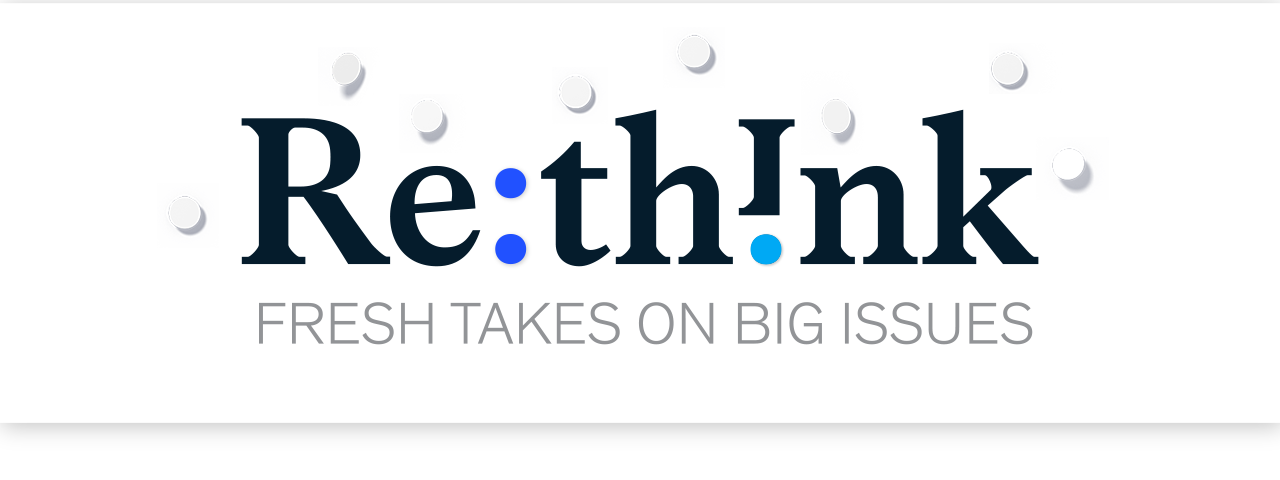

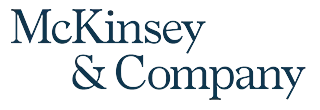
FOLLOW US: